BJ8Healeys
Jedi Warrior
Offline
If a shock does not leak, yet occasionally needs topping off, where does the oil go?
Well, when I say they don't leak, they don't "drip" but might seep slowly enough that they require topping up every few years or so, depending on how much the car is driven. The last time I serviced them according to my logbook was 2 April 2015. I did it again 30 April 2019 to prepare to the trip to Conclave -- 5,500 miles between the two dates. None of them required a significant amount of oil. I use motorcycle fork oil because it has seal conditioning additive. The container says "Heavy 20W, PJ1 Motorcycle Fork Tuning Oil".

 Hi Guest!
Hi Guest!

 smilie in place of the real @
smilie in place of the real @
 Pretty Please - add it to our Events forum(s) and add to the calendar! >>
Pretty Please - add it to our Events forum(s) and add to the calendar! >> 


